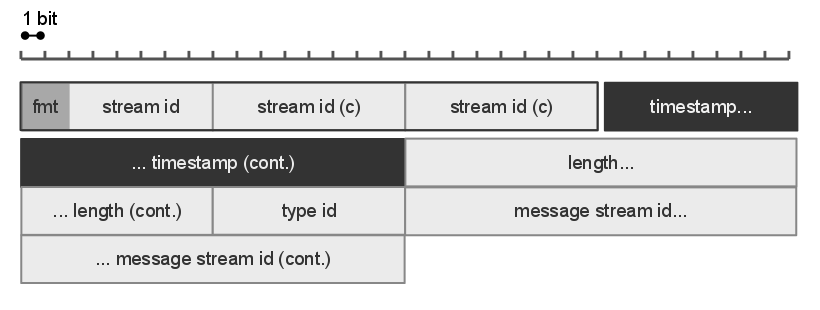|
Real Time Messaging Protocol
Real-Time Messaging Protocol (RTMP) is a communication protocol for streaming media, streaming audio, video, and data over the Internet. Originally developed as a proprietary protocol by Macromedia for streaming between Flash Player and the Flash Communication Server, Adobe Systems, Adobe (which acquired Macromedia) has released an incomplete version of the specification of the protocol for public use. The RTMP protocol has multiple variations: # RTMP proper, the "plain" protocol which works on top of Transmission Control Protocol (TCP) and uses port number 1935 by default. # RTMPS, which is RTMP over a Transport Layer Security (TLS/SSL) connection. # RTMPE, which is RTMP encrypted using Adobe's own security mechanism. While the details of the implementation are proprietary, the mechanism uses industry standard cryptographic primitives. # RTMPT, which is encapsulation (networking), encapsulated within HTTP requests to traverse firewall (computing), firewalls. RTMPT is frequently f ... [...More Info...] [...Related Items...] OR: [Wikipedia] [Google] [Baidu] |
Macromedia
Macromedia, Inc. was an American graphics, multimedia, and web development software company headquartered in San Francisco, California, that made products such as Adobe Flash, Flash and Adobe Dreamweaver, Dreamweaver. It was purchased by its rival Adobe Systems on December 3, 2005. History Macromedia was formed from the April 1992 merger of Authorware Inc. (makers of Macromedia Authorware, Authorware) and MacroMind, MacroMind–Paracomp (makers of Adobe Director, MacroMind Director). At the time, analysts estimated the multimedia software industry to be worth $200 million, and the combined company would control 20% of the market. Tim Mott of MacroMind was named chairman and chief executive officer and Bud Colligan of Authorware became president and CEO of the new company. Adobe Director, Director, an interactive multimedia-authoring tool used to make presentations, animations, CD-ROM, CD-ROMs and information kiosks, served as the company's flagship product. Director was used in ... [...More Info...] [...Related Items...] OR: [Wikipedia] [Google] [Baidu] |
Multiplexed
In telecommunications and computer networking, multiplexing (sometimes contracted to muxing) is a method by which multiple analog or digital signals are combined into one signal over a shared medium. The aim is to share a scarce resource—a physical transmission medium. For example, in telecommunications, several telephone calls may be carried using one wire. Multiplexing originated in telegraphy in the 1870s, and is now widely applied in communications. In telephony, George Owen Squier is credited with the development of telephone carrier multiplexing in 1910. The multiplexed signal is transmitted over a communication channel such as a cable. The multiplexing divides the capacity of the communication channel into several logical channels, one for each message signal or data stream to be transferred. A reverse process, known as demultiplexing, extracts the original channels on the receiver end. A device that performs the multiplexing is called a multiplexer (MUX), and a d ... [...More Info...] [...Related Items...] OR: [Wikipedia] [Google] [Baidu] |
Adobe Flash
Adobe Flash (formerly Macromedia Flash and FutureSplash) is a mostly discontinuedAlthough it is discontinued by Adobe Inc., for the Chinese market it is developed by Zhongcheng and for the international enterprise market it is developed by Harman International. multimedia software platform used for production of animations, rich internet applications, desktop applications, mobile apps, mobile games, and embedded web browser video players. About Flash displays text, vector graphics, and raster graphics to provide animations, video games, and applications. It allows streaming of audio and video, and can capture mouse, keyboard, microphone, and camera input. Artists may produce Flash graphics and animations using Adobe Animate (formerly known as Adobe Flash Professional). Software developers may produce applications and video games using Adobe Flash Builder, FlashDevelop, Flash Catalyst, or any text editor combined with the Apache Flex SDK. End users view Flash co ... [...More Info...] [...Related Items...] OR: [Wikipedia] [Google] [Baidu] |
Patent License
A license (American English) or licence (Commonwealth English) is an official permission or permit to do, use, or own something (as well as the document of that permission or permit). A license is granted by a party (licensor) to another party (licensee) as an element of an agreement between those parties. In the case of a license issued by a government, the license is obtained by applying for it. In the case of a private party, it is by a specific agreement, usually in writing (such as a lease or other contract). The simplest definition is "A license is a promise not to sue", because a license usually either permits the licensed party to engage in an illegal activity, and subject to prosecution, without the license (e.g. fishing, driving an automobile, or operating a broadcast radio or television station), or it permits the licensed party to do something that would violate the rights of the licensing party (e.g. make copies of a copyrighted work), which, without the licens ... [...More Info...] [...Related Items...] OR: [Wikipedia] [Google] [Baidu] |
Landing Page
In online marketing, a landing page, sometimes known as a "lead capture page", "single property page", "static page", "squeeze page" or a "destination page", is a single web page that appears in response to clicking on a search engine optimized search result, marketing promotion, marketing email or an online advertisement. The landing page will usually display directed sales copy that is a logical extension of the advertisement, search result or link. Landing pages are used for lead generation. The actions that a visitor takes on a landing page are what determine an advertiser's conversion rate. A landing page may be part of a microsite or a single page within an organization's main web site. Landing pages are often linked to social media, e-mail campaigns, search engine marketing campaigns, high-quality articles or "affiliate account" in order to enhance the effectiveness of the advertisements. The general goal of a landing page is to convert site visitors into sales or l ... [...More Info...] [...Related Items...] OR: [Wikipedia] [Google] [Baidu] |
Firewall (networking)
In computing, a firewall is a network security system that monitors and controls incoming and outgoing network traffic based on configurable security rules. A firewall typically establishes a barrier between a trusted network and an untrusted network, such as the Internet or between several VLANs. Firewalls can be categorized as network-based or host-based. History The term '' firewall'' originally referred to a wall to confine a fire within a line of adjacent buildings. Later uses refer to similar structures, such as the metal sheet separating the engine compartment of a vehicle or aircraft from the passenger compartment. The term was applied in the 1980s to network technology that emerged when the Internet was fairly new in terms of its global use and connectivity. The predecessors to firewalls for network security were routers used in the 1980s. Because they already segregated networks, routers could filter packets crossing them. Before it was used in real-life computin ... [...More Info...] [...Related Items...] OR: [Wikipedia] [Google] [Baidu] |
Hypertext Transfer Protocol
HTTP (Hypertext Transfer Protocol) is an application layer protocol in the Internet protocol suite model for distributed, collaborative, hypermedia information systems. HTTP is the foundation of data communication for the World Wide Web, where hypertext documents include hyperlinks to other resources that the user can easily access, for example by a mouse click or by tapping the screen in a web browser. Development of HTTP was initiated by Tim Berners-Lee at CERN in 1989 and summarized in a simple document describing the behavior of a client and a server using the first HTTP version, named 0.9. That version was subsequently developed, eventually becoming the public 1.0. Development of early HTTP Requests for Comments (RFCs) started a few years later in a coordinated effort by the Internet Engineering Task Force (IETF) and the World Wide Web Consortium (W3C), with work later moving to the IETF. HTTP/1 was finalized and fully documented (as version 1.0) in 1996. It evolved ( ... [...More Info...] [...Related Items...] OR: [Wikipedia] [Google] [Baidu] |
Real-time Communication
Real-time communication (RTC) is a category of software protocols and communication hardware media that gives real-time guarantees, which is necessary to support real-time guarantees of real-time computing. Real-time communication Protocols (computing), protocols are dependent not only on the Data integrity, validity and integrity of data transferred but also the timeliness of the transfer. Real-time communication systems are generally understood as one of two types: ''Hard Real-Time (HRT)'' and ''Soft Real-Time (SRT)''. The difference between a hard and soft real-time communication system is the consequences of incorrect operation. Safety-critical systems capable of causing catastrophic consequences upon a fault, such as Fly-by-wire, aircraft fly-by-wire systems, are designated as hard real-time, whereas non-critical but ideally real-time systems, such as hotel reservation systems, are designated as soft real-time. The designation of a real-time communication system as hard or sof ... [...More Info...] [...Related Items...] OR: [Wikipedia] [Google] [Baidu] |
Action Message Format
Action Message Format (AMF) is a binary format used to serialize object graphs such as ActionScript objects and XML, or send messages between an Adobe Flash client and a remote service, usually a Flash Media Server or third party alternatives. The Actionscript 3 language provides classes for encoding and decoding from the AMF format. The format is often used in conjunction with Adobe's RTMP to establish connections and control commands for the delivery of streaming media. In this case, the AMF data is encapsulated in a ''chunk'' which has a header which defines things such as the message length and type (whether it is a "ping", "command" or media data). Format analysis AMF was introduced with Flash Player 6, and this version is referred to as AMF0. It was unchanged until the release of Flash Player 9 and ActionScript 3.0, when new data types and language features prompted an update, called AMF3. Flash Player 10 added vector and dictionary data types documented in a revised spec ... [...More Info...] [...Related Items...] OR: [Wikipedia] [Google] [Baidu] |
Remote Procedure Call
In distributed computing, a remote procedure call (RPC) is when a computer program causes a procedure (subroutine) to execute in a different address space (commonly on another computer on a shared computer network), which is written as if it were a normal (local) procedure call, without the programmer explicitly writing the details for the remote interaction. That is, the programmer writes essentially the same code whether the subroutine is local to the executing program, or remote. This is a form of server interaction (caller is client, executor is server), typically implemented via a request–response message passing system. In the object-oriented programming paradigm, RPCs are represented by remote method invocation (RMI). The RPC model implies a level of location transparency, namely that calling procedures are largely the same whether they are local or remote, but usually, they are not identical, so local calls can be distinguished from remote calls. Remote calls are usually o ... [...More Info...] [...Related Items...] OR: [Wikipedia] [Google] [Baidu] |



